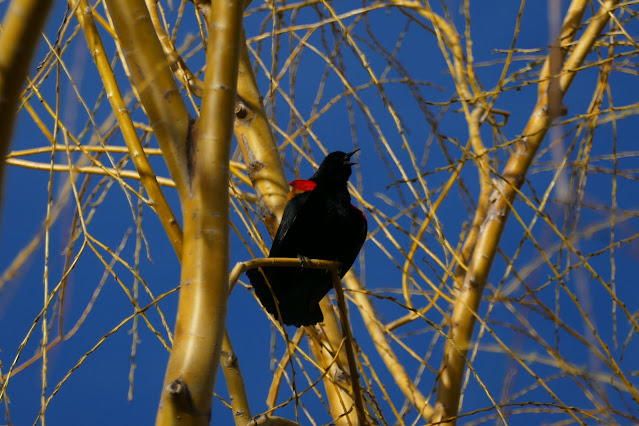 |
| Geese flying over Hyatt Hidden Lakes Reserve, Boise |
On the West Bench the City of Boise has created a small haven for birds, especially during migration. A combination stormwater treatment facility and environmental education center, the 53-acre site provides public access for people of all ages and abilities. The wetlands reserve was created through a private land donation from the Hyatt family and federal and local funding. In addition to being an oasis for birds and other wildlife, the site is providing important information pertaining to capturing and filtering stormwater to improve water quality.
This time of year, the birds are abundant. The first sound you will most likely hear as you enter the reserve from the parking lot is that of Red-winged blackbirds.
 |
| Male Red-winged blackbird calling and displaying his colorful wings |
 |
| Female Red-winged blackbirds look very different and more easily blend into their surroundings |
There were numerous American Coots. Coots are present year-round in Idaho. It is not classified as a duck as it does not have webbed feet, those that are more like a chicken's, but lobed. To take off, it needs space to scrambles atop of the water while flapping its wings.
 |
| American Coot with noticeable red patch on its forehead |
Many of the ducks were paired with their mates. Most males will stay with the female until the eggs are laid and will leave the incubation and rearing to the female.
 |
| Male and female Mallard |
After the Mallard ducklings hatch, they will be ready to swim within a few hours. The mother and young will remain as a family until the young can fend for themselves in 50 to 60 days. The males will typically select a new mate in the fall.
Similar to many ducks, Gadwalls pair up in the fall and leave the female to rear the brood in the spring.
.JPG) |
| Female Gadwall |
The mottled coloring of the female Gadwall resembles a female Mallard, while the male's coloring is more smooth. They are both attractive birds.
.JPG) |
| Male Gadwall |
The Northern Shoveler is named for its large bill which resembles a shovel and is used to scoop and filter food before consumption. They are large, beautiful ducks and were plentiful in the pond. They form pairs in the fall/winter and during spring migration. They often will stay with their mate through incubation. According to the Cornell Lab's breeding map, they migrate through most of Idaho, settling slightly further north and east, although some may stay year round in the southwest corner of the state.
 |
| This Northern Shoveler pair appeared to be dancing together. |
The photo below shows what I believe is a Lesser Scaup pair, although my skills are not yet adept enough to distinguish the difference between Lesser and Greater Scaups. The greater scaup is slightly larger and is supposed to have a more rounded head, but I would need to see two together to decipher the differences. Unlike the ducks described above, which are dabbling ducks, Scaups are diving ducks, meaning they dive underwater to search for food. Lesser Scaups are the most abundant diving duck in North America and migrate as far south as Central America. They may stay here in Idaho to breed. In the fall they will migrate to the west coast or continue further south.
.JPG) |
| Male and female Scaup |
There were at least three Great Blue herons the day I was there and I was fortunate to witness one hunting and catching a fish.
.JPG) |
| Great Blue heron after capturing its dinner |
In addition to the water birds, The Hyatt Hidden Lakes Reserve supports upland species of birds and mammals. It is an amazing place, within a relative urban area, for people to go and appreciate nature.
No comments:
Post a Comment